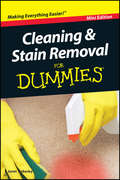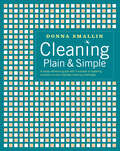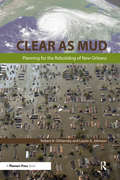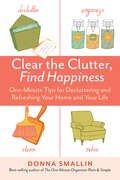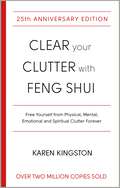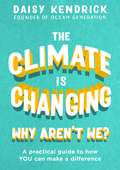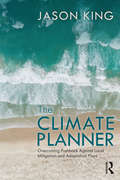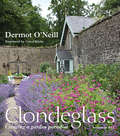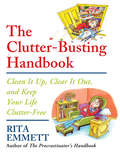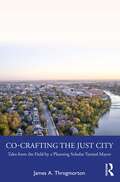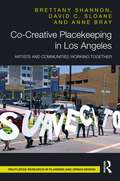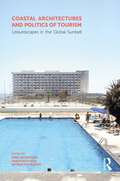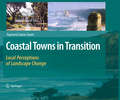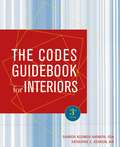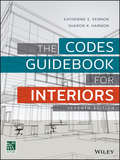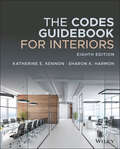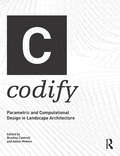- Table View
- List View
Cleaning and Stain Removal For Dummies, Mini Edition
by Janet SobeskyMake light work of housework and keep your home in the shape you want it to be Help is here! From getting wine stains off the carpet to making your glasses sparkle, we've got the book that will transform your household into a clean machine. Filled with cleaning tips for the major rooms of your home and the major stains you'll encounter, this is your pocket guide to a well-run home. Open the book and find: -Timesaving tips for cleaning the right way with both chemical and natural cleaners - The right tools for each cleaning task - The easiest and quickest ways to clean bathrooms and kitchens - How to remove stains from carpet and clothes
Cleaning Plain & Simple: A Ready Reference Guide with Hundreds of Sparkling Solutions to Your Everyday Cleaning Challenges
by Donna SmallinLearn how to clean smarter, not harder, and you&’ll have more time to do the things you love. With plain and simple advice on everything from dusting and swabbing to polishing and vacuuming, best-selling author Donna Smallin shows you how to make the most of your valuable cleaning time. Hundreds of quick tips and practical solutions for every imaginable cleaning situation promise you the sparkling, healthy environment you want for your family. This publication conforms to the EPUB Accessibility specification at WCAG 2.0 Level AA.
Clear as Mud: Planning for the Rebuilding of New Orleans
by Laurie Johnson Robert B. OlshanskyPlanning the rebuilding of New Orleans after Hurricanes Katrina and Rita has been among the greatest urban planning challenges of our time. Since 2005, Robert B. Olshansky and Laurie A. Johnson, urban planners who specialize in disaster planning and recovery, have been working to understand, in real time, the difficult planning decisions in this unusual situation. As both observers of and participants in the difficult process of creating the Unified New Orleans Plan, Olshansky and Johnson bring unparalleled detail and insight to this complex story. The recovery process has been slow and frustrating, in part because New Orleans was so unprepared for the physical challenges of such a disaster, but also because it lacked sufficient planning mechanisms to manage community reconstruction in a viable way. New Orleans has had to rebuild its buildings and institutions, but it has also had to create a community planning structure that is seen as both equitable and effective, while also addressing the concerns and demands of state, federal, nonprofit, and private-sector stakeholders. In documenting how this unprecedented process occurred, Olshansky and Johnson spent years on the ground in New Orleans, interviewing leaders and citizens and abetting the design and execution of the Unified New Orleans Plan. Their insights will help cities across the globe recognize the challenges of rebuilding and recovering after disaster strikes.
Clear as Mud: Planning for the Rebuilding of New Orleans
by Laurie Johnson Robert B. OlshanskyPlanning the rebuilding of New Orleans after Hurricanes Katrina and Rita has been among the greatest urban planning challenges of our time. Since 2005, Robert B. Olshansky and Laurie A. Johnson, urban planners who specialize in disaster planning and recovery, have been working to understand, in real time, the difficult planning decisions in this unusual situation. As both observers of and participants in the difficult process of creating the Unified New Orleans Plan, Olshansky and Johnson bring unparalleled detail and insight to this complex story. The recovery process has been slow and frustrating, in part because New Orleans was so unprepared for the physical challenges of such a disaster, but also because it lacked sufficient planning mechanisms to manage community reconstruction in a viable way. New Orleans has had to rebuild its buildings and institutions, but it has also had to create a community planning structure that is seen as both equitable and effective, while also addressing the concerns and demands of state, federal, nonprofit, and private-sector stakeholders. In documenting how this unprecedented process occurred, Olshansky and Johnson spent years on the ground in New Orleans, interviewing leaders and citizens and abetting the design and execution of the Unified New Orleans Plan. Their insights will help cities across the globe recognize the challenges of rebuilding and recovering after disaster strikes.
Clear the Clutter, Find Happiness: One-Minute Tips for Decluttering and Refreshing Your Home and Your Life
by Donna SmallinClear the Clutter offers practical ways to clean and organize that you can accomplish in just a few minutes at a time.
Clear Your Clutter With Feng Shui: Free Yourself From Physical, Mental, Emotional, And Spiritual Clutter Forever
by Karen Kingston'What a great book . . . I have read it twice in a week and underline more of it each time. Thanks, Karen, for helping me to simplify my life in a joyful way.' - Louise HayClearing clutter can radically transform your life. Drawing on her wealth of experience as a feng shui, space clearing and clutter clearing consultant, Karen Kingston explains how clutter is stuck energy that has far-reaching physical, mental, emotional and spiritual effects. This book will motivate you to clutter-clear as never before, once you realise just how much your junk has been holding you back!Learn:- Why people keep clutter- How clutter causes stagnation in every area of your life- Why clearing clutter is essential for effective feng shui- How to clear clutter quickly and effectively- Karen Kingston's top ten clutter clearing tips
The Climate is Changing, Why Aren't We?: A practical guide to how you can make a difference
by Daisy Kendrick'An inspirational and motivational must-read, packed with practical tips to push for positive change' Zanna van DijkThe climate is changing, so why aren't we? After all, we are the generation of change. The severity of climate change leaves no one indifferent. The Climate is Changing, Why Aren't We? will not try to convince you that climate change exists - we know that. It offers easy to understand insights into the structures that suffocate our future, while upholding a sense of optimism and humanising the climate story. From the clothes you buy, plastics you use and food you eat, to knowing how to harness the power of social media and technology to get our voices heard and demand climate action, Daisy Kendrick, founder of Ocean Generation, weaves together inspirational stories, shocking statistics and easy green switches to make in your everyday life to tackle climate change on an individual level. The Climate is Changing, Why Aren't We? will help to grant future generations the rights they deserve.
The Climate Planner: Overcoming Pushback Against Local Mitigation and Adaptation Plans
by Jason KingThe Climate Planner is about overcoming the objections to climate change mitigation and adaption that urban planners face at a local level. It shows how to draft climate plans that encounter less resistance because they involve the public, stakeholders, and decisionmakers in a way that builds trust, creates consensus, and leads to implementation. Although focused on the local level, this book discusses climate basics such as carbon dioxide levels in the atmosphere, the Intergovernmental Panel on Climate Change, the Paris Agreement of 2015, worldwide energy generation forecasts, and other items of global concern in order to familiarize urban planners and citizen planners with key concepts that they will need to know in order to be able to host climate conversations at the local level. The many case studies from around the United States of America show how communities have encountered pushback and bridged the implementation gap, the gap between plan and reality, thanks to a commitment to substantive public engagement. The book is written for urban planners, local activists, journalists, elected or appointed representatives, and the average citizen worried about climate breakdown and interested in working to reshape the built environment.
The Climate Planner: Overcoming Pushback Against Local Mitigation and Adaptation Plans
by Jason KingThe Climate Planner is about overcoming the objections to climate change mitigation and adaption that urban planners face at a local level. It shows how to draft climate plans that encounter less resistance because they involve the public, stakeholders, and decisionmakers in a way that builds trust, creates consensus, and leads to implementation. Although focused on the local level, this book discusses climate basics such as carbon dioxide levels in the atmosphere, the Intergovernmental Panel on Climate Change, the Paris Agreement of 2015, worldwide energy generation forecasts, and other items of global concern in order to familiarize urban planners and citizen planners with key concepts that they will need to know in order to be able to host climate conversations at the local level. The many case studies from around the United States of America show how communities have encountered pushback and bridged the implementation gap, the gap between plan and reality, thanks to a commitment to substantive public engagement. The book is written for urban planners, local activists, journalists, elected or appointed representatives, and the average citizen worried about climate breakdown and interested in working to reshape the built environment.
Clondeglass: Creating a Garden Paradise
by Dermot O'NeillWhen Dermot O'Neill bought Clondeglass over a decade ago, the derelict house and totally overgrown walled garden were on the edge of collapse. Here, Dermot takes us on a tour of the different sections of the totally renovated garden, showing his particular plant passions and interests, covering trees, shrubs, perennials, bulbs and structures. We start in the Rose Garden, exploring the wide range of roses, before moving onto the Double Borders and Courtyard. Inside the Polytunnel we find a host of vegetables and more tropical plants. Then along the West Border we come to The Temple, a timber haven to relax and escape the rain! The Potager is devoted to vegetables and fruit trees, including a number of rare species and Irish heritage varieties. Finally The Poultry, with Dermot's own Toulouse geese. Remarkable before and after photographs document the enormous changes, as well as plans to show what's still to come.
The Clutter-Busting Handbook: Clean It Up, Clear It Out, and Keep Your Life Clutter-Free
by Rita EmmettThe Clutter Busting Handbook is a streamlined guide to uncluttering your life from the best-selling author of The Procrastinator's Handbook.We are the clutter generation, inundated by a seemingly daily or weekly influx of clothes, accessories, gadgets, catalogs, mail, and e-mail. Clutter crowds our lives, is a chief source of stress, contributes to sidetracked dreams and opportunities, and can cause guilt and anxiety. If clutter is a problem in your life, then Rita Emmett-herself a reformed clutterer-can help you tame it. The Clutter-Busting Handbook is a concise, energizing guide giving readers insight and direction as well as proven tips, methods, and strategies that will change lives for the better. Emmett reveals: - the four primary causes of clutter - that cluttering is a habit that can be broken- the powerful connection between clutter and procrastination- how to help a pack rat part with unneeded objects- how to prevent clutter from returning, forever. As entertaining as she is helpful, Emmett offers practical advice on separating what you need or truly want from what you have been hanging onto for the wrong reasons. Her combination of experience and good humor-based on her hundreds of seminars and advice received from people all over the country-will win over the most reluctant convert.
Co-Crafting the Just City: Tales from the Field by a Planning Scholar Turned Mayor
by James A. ThrogmortonThe 2016 election in Iowa City would provide an opportunity that planning faculty have long desired: the opportunity for one of their own to serve as mayor. In this new book, former Iowa City Mayor and Professor Emeritus James A. Throgmorton provides readers a sense of what democratically-elected city council members and mayors in the United States do and what it feels like to occupy and enact those roles. He does so by telling a set of “practice stories” focusing primarily, but not exclusively, on what he, a retired planning professor at the University of Iowa, experienced and learned as a council member from 2012 through 2019 and, simultaneously, as mayor from 2016 through 2019. The book proposes a practical, action-oriented theory about how city futures are being (and can be) shaped, showing that storytelling of various kinds plays a very important but poorly understood role in the co-crafting process, and demonstrating that skillful use of ethically-sound persuasive storytelling (especially by mayors) can improve our collective capacity to create better places. The book documents efforts to alleviate race-related inequities, increase the supply of affordable housing, adopt an ambitious climate action plan, improve relationships between city government and diverse marginalized communities, pursue more inclusive and sustainable land development codes/policies, and more. It will be of great interest to urban planning faculty and students and elected officials looking to collaboratively craft better cities for the future.
Co-Crafting the Just City: Tales from the Field by a Planning Scholar Turned Mayor
by James A. ThrogmortonThe 2016 election in Iowa City would provide an opportunity that planning faculty have long desired: the opportunity for one of their own to serve as mayor. In this new book, former Iowa City Mayor and Professor Emeritus James A. Throgmorton provides readers a sense of what democratically-elected city council members and mayors in the United States do and what it feels like to occupy and enact those roles. He does so by telling a set of “practice stories” focusing primarily, but not exclusively, on what he, a retired planning professor at the University of Iowa, experienced and learned as a council member from 2012 through 2019 and, simultaneously, as mayor from 2016 through 2019. The book proposes a practical, action-oriented theory about how city futures are being (and can be) shaped, showing that storytelling of various kinds plays a very important but poorly understood role in the co-crafting process, and demonstrating that skillful use of ethically-sound persuasive storytelling (especially by mayors) can improve our collective capacity to create better places. The book documents efforts to alleviate race-related inequities, increase the supply of affordable housing, adopt an ambitious climate action plan, improve relationships between city government and diverse marginalized communities, pursue more inclusive and sustainable land development codes/policies, and more. It will be of great interest to urban planning faculty and students and elected officials looking to collaboratively craft better cities for the future.
Co-Creative Placekeeping in Los Angeles: Artists and Communities Working Together (Routledge Research In Planning And Urban Design Ser.)
by Brettany Shannon David C. Sloane Anne BrayCo-Creative Placekeeping in Los Angeles is a novel examination of Los Angeles-based socially engaged art (SEA) practitioners’ equitable placekeeping efforts. A new concept, equitable placekeeping describes the inclination of historically marginalized community members to steward their neighborhood’s development, improve local amenities, engage in social and cultural production, and assert a mutual sense of self-definition—and the efforts of SEA artists to aid them. Emerging from in-depth interviews with eight Southern California artists and teams, Co-Creative reveals how artists engage community members, sustain relationships, and defy the presumption that residents cannot speak for themselves. Drawing on these artists and theoretical analysis of their praxes, the book explicates equitable community engagement by exploring not just the creative projects but also the underlying phenomena that inspire and sustain them: community, engagement, relationships, and defiance. What further sets this book apart is how it deviates from the conventional who and what of SEA projects to foreground the how and the why that inspire and necessitate collectively creative action. Co-Creative is for anyone studying arts-based community development and gentrification, given it complicates and enriches the current conversation about art’s undeniable and increasingly controversial role in neighborhood change. It will also be of interest to researchers and students of urban studies.
Co-Creative Placekeeping in Los Angeles: Artists and Communities Working Together (Routledge Research In Planning And Urban Design Ser.)
by Brettany Shannon David C. Sloane Anne BrayCo-Creative Placekeeping in Los Angeles is a novel examination of Los Angeles-based socially engaged art (SEA) practitioners’ equitable placekeeping efforts. A new concept, equitable placekeeping describes the inclination of historically marginalized community members to steward their neighborhood’s development, improve local amenities, engage in social and cultural production, and assert a mutual sense of self-definition—and the efforts of SEA artists to aid them. Emerging from in-depth interviews with eight Southern California artists and teams, Co-Creative reveals how artists engage community members, sustain relationships, and defy the presumption that residents cannot speak for themselves. Drawing on these artists and theoretical analysis of their praxes, the book explicates equitable community engagement by exploring not just the creative projects but also the underlying phenomena that inspire and sustain them: community, engagement, relationships, and defiance. What further sets this book apart is how it deviates from the conventional who and what of SEA projects to foreground the how and the why that inspire and necessitate collectively creative action. Co-Creative is for anyone studying arts-based community development and gentrification, given it complicates and enriches the current conversation about art’s undeniable and increasingly controversial role in neighborhood change. It will also be of interest to researchers and students of urban studies.
Coastal Architectures and Politics of Tourism: Leisurescapes in the Global Sunbelt
by Sibel Bozdo 287 An Panayiota Pyla Petros PhokaidesThis volume offers a critical and complicated picture of how leisure tourism connected the world after the World War II, transforming coastal lands, traditional societies, and national economies in new ways.The 21 chapters in this book analyze selected case studies of architectures and landscapes around the world, contextualizing them within economic geographies of national development, the geopolitics of the Cold War, the legacies of colonialism, and the international dynamics of decolonization. Postwar leisure tourism evokes a rich array of architectural spaces and altered coastal landscapes, which is explored in this collection through discussions of tourism developments in the Mediterranean littoral, such as Greece, Turkey, and southern France, as well as compelling analyses of Soviet bloc seaside resorts along the Black Sea and Baltic coasts, and in beachscapes and tourism architectures of western and eastern hemispheres, from Southern California to Sri Lanka, South Korea, and Egypt. This collection makes a compelling argument that "leisurescapes," far from being supra-ideological and apolitical spatial expressions of modernization, development, and progress, have often concealed histories of conflict, violence, social inequalities, and environmental degradation. It will be of interest to architectural and urban historians, architects and planners, as well as urban geographers, economic and environmental historians.
Coastal Architectures and Politics of Tourism: Leisurescapes in the Global Sunbelt
by Sibel BozdoǧanThis volume offers a critical and complicated picture of how leisure tourism connected the world after the World War II, transforming coastal lands, traditional societies, and national economies in new ways.The 21 chapters in this book analyze selected case studies of architectures and landscapes around the world, contextualizing them within economic geographies of national development, the geopolitics of the Cold War, the legacies of colonialism, and the international dynamics of decolonization. Postwar leisure tourism evokes a rich array of architectural spaces and altered coastal landscapes, which is explored in this collection through discussions of tourism developments in the Mediterranean littoral, such as Greece, Turkey, and southern France, as well as compelling analyses of Soviet bloc seaside resorts along the Black Sea and Baltic coasts, and in beachscapes and tourism architectures of western and eastern hemispheres, from Southern California to Sri Lanka, South Korea, and Egypt. This collection makes a compelling argument that "leisurescapes," far from being supra-ideological and apolitical spatial expressions of modernization, development, and progress, have often concealed histories of conflict, violence, social inequalities, and environmental degradation. It will be of interest to architectural and urban historians, architects and planners, as well as urban geographers, economic and environmental historians.
Coastal Towns in Transition: Local Perceptions of Landscape Change
by Raymond James GreenMany coastal areas around the world are experiencing dramatic landscape changes as a result of increased tourism development and the "sea change phenomenon" – the migration of affluent urbanites to small coastal towns seeking beautiful, natural surroundings. In response to these changes local residents in these places often complain that the distinctive character of their towns and/or individual neighborhoods is being lost or degraded. Coastal Towns in Transition looks at how changes due to unsympathetic development of the built environment and modification of the natural landscape are perceived to negatively impact on the character of small coastal towns. The book explores the concept of town character, and associated notions of sense of place, genius loci and place identity, as conceptualised by local residents in several coastal town communities along Australia’s Great Ocean Road. Findings of a four-year study involving over 1800 respondents from these communities are used to explore theoretical and methodological issues associated with the assessment of place character in the context of coastal towns that are experiencing rapid environmental change. This book will be of interest to planners and environmental designers, as well as scholars in both landscape studies and social science and planning fields who are interested in the sustainable development of coastal areas. The case studies and associated planning and design strategies, together with the bibliography of selected relevant literature, will provide an invaluable reference for these scholars.
The Codes Guidebook for Interiors
by Sharon K. Harmon Katherine E. KennonNow available in an updated and expanded third edition, The Codes Guidebook for Interiors incorporates the latest standards for interior projects. The book presents the International Building Code, Life Safety Code, NFPA 5000, ICC/ANSI accessibility standard, and many others in a clear, jargon-free style. In addition, you'll find a thorough referencce for the NCIDQ exam or the interior portion of the ARE. Whether you're an architect, interior designer, facilities manager, construction manager, or developer, The Codes Guidebook for Interiors, Third Edition is an indispensable tool of the trade. Order your copy today.
The Codes Guidebook for Interiors: Wiley E-text Folder And Interactive Resource Center Access Card
by Katherine E. Kennon Sharon K. HarmonInterior codes and standards reference of choice for designers and architects, updated and revised Completely revised and updated, the seventh edition of The Codes Guidebook to Interiors is the only book devoted exclusively to codes that are applicable to interior designers. The guide features jargon-free explanations of all the codes and standards that are relevant to designers and architects, including performance codes, building and finish standards, energy codes, and ADA standards. In addition, the dozens of examples and a greatly enhanced with a set of illustrations, including floor plans, that clearly show how codes apply to real-world project. Written by Katherine E. Kennon (a professional architect and facilities planner) and Sharon Koomen Harmon (a professional interior designer and educator) are experts on interior design and architecture codes. Updated coverage contains the most recent ICC codes, including the International Building Code and new material on the ICC International Green Construction Code, as well as the NFPA's most recent Life code. The authors address a wide-variety of building and project types (large and small) and they offer information on single family homes and historical and existing buildings. The seventh edition includes: Easy-to-navigate format geared toward the code process as a whole A step-by-step guide through the codes relevant at each stage in the design process The newest changes to the ADA Standards and ICC/ASI accessibility requirements A companion site that offers interactive checklists, flashcards, PowerPoint lecture slides, and an Instructor's Manual Having all applicable codes in a single resource saves hours of research time, and can dramatically reduce the potential for costly planning oversights. Whether renovation or new construction, small or large, codes apply to every project. The Codes Guidebook for Interiors provides designers with the comprehensive information they need to stay up-to-date.
The Codes Guidebook for Interiors
by Katherine E. Kennon Sharon K. HarmonInterior codes and standards reference of choice for designers and architects, updated and revised Completely revised and updated, the seventh edition of The Codes Guidebook to Interiors is the only book devoted exclusively to codes that are applicable to interior designers. The guide features jargon-free explanations of all the codes and standards that are relevant to designers and architects, including performance codes, building and finish standards, energy codes, and ADA standards. In addition, the dozens of examples and a greatly enhanced with a set of illustrations, including floor plans, that clearly show how codes apply to real-world project. Written by Katherine E. Kennon (a professional architect and facilities planner) and Sharon Koomen Harmon (a professional interior designer and educator) are experts on interior design and architecture codes. Updated coverage contains the most recent ICC codes, including the International Building Code and new material on the ICC International Green Construction Code, as well as the NFPA's most recent Life code. The authors address a wide-variety of building and project types (large and small) and they offer information on single family homes and historical and existing buildings. The seventh edition includes: Easy-to-navigate format geared toward the code process as a whole A step-by-step guide through the codes relevant at each stage in the design process The newest changes to the ADA Standards and ICC/ASI accessibility requirements A companion site that offers interactive checklists, flashcards, PowerPoint lecture slides, and an Instructor's Manual Having all applicable codes in a single resource saves hours of research time, and can dramatically reduce the potential for costly planning oversights. Whether renovation or new construction, small or large, codes apply to every project. The Codes Guidebook for Interiors provides designers with the comprehensive information they need to stay up-to-date.
The Codes Guidebook for Interiors
by Katherine E. Kennon Sharon K. HarmonTHE INTERIOR CODES AND STANDARDS REFERENCE OF CHOICE FOR DESIGNERS AND ARCHITECTS—UPDATED FOR THE 2018 AND 2021 CODES If you are involved with the design or management of buildings and spaces, it is important to remain up-to-date on the ever-evolving codes and standards that keep communities safe. With over 80,000 copies sold, The Codes Guidebook for Interiors continues to provide comprehensive explanations of the major codes and standards applicable to commercial and residential interior projects. The easily navigable format gives clear perspective to how these often confusing concepts and requirements are integrated into real world practice, helping designers incorporate the relevant standards into their projects. Updated with the most recent changes and insights to the codes and standards of the ICC, NFPA, ANSI, ADA, and other standards, the Eighth Edition provides unparalleled and integrated guidance on building safety, accessibility, sustainability, energy efficiency, and more. Updates to the Eighth Edition include: Explanations of code requirements, highlighting the latest changes in the 2018 and 2021 ICC codes, including the International Building Code and the NFPA’s Life Safety Code Clarifications to how and when the ADA, ABA and the ICC/ANSI accessibility requirements will apply to a project Introduction to the codes and standards that address sustainability in typical projects In-depth examinations of fire and smoke resistant assemblies, fire protection systems, and plumbing and mechanical requirements A companion website with printable study flashcards, instructor’s manual, and PowerPoint slides for use in academic settings Digital and printable code checklists that can guide code research for professional projects and use in a design studio Current, practical, and relevant to nearly any interior or architectural project, The Codes Guidebook for Interiors provides invaluable insight and reference for both student and professional interior designers and architects.
The Codes Guidebook for Interiors
by Katherine E. Kennon Sharon K. HarmonTHE INTERIOR CODES AND STANDARDS REFERENCE OF CHOICE FOR DESIGNERS AND ARCHITECTS—UPDATED FOR THE 2018 AND 2021 CODES If you are involved with the design or management of buildings and spaces, it is important to remain up-to-date on the ever-evolving codes and standards that keep communities safe. With over 80,000 copies sold, The Codes Guidebook for Interiors continues to provide comprehensive explanations of the major codes and standards applicable to commercial and residential interior projects. The easily navigable format gives clear perspective to how these often confusing concepts and requirements are integrated into real world practice, helping designers incorporate the relevant standards into their projects. Updated with the most recent changes and insights to the codes and standards of the ICC, NFPA, ANSI, ADA, and other standards, the Eighth Edition provides unparalleled and integrated guidance on building safety, accessibility, sustainability, energy efficiency, and more. Updates to the Eighth Edition include: Explanations of code requirements, highlighting the latest changes in the 2018 and 2021 ICC codes, including the International Building Code and the NFPA’s Life Safety Code Clarifications to how and when the ADA, ABA and the ICC/ANSI accessibility requirements will apply to a project Introduction to the codes and standards that address sustainability in typical projects In-depth examinations of fire and smoke resistant assemblies, fire protection systems, and plumbing and mechanical requirements A companion website with printable study flashcards, instructor’s manual, and PowerPoint slides for use in academic settings Digital and printable code checklists that can guide code research for professional projects and use in a design studio Current, practical, and relevant to nearly any interior or architectural project, The Codes Guidebook for Interiors provides invaluable insight and reference for both student and professional interior designers and architects.
Codify: Parametric and Computational Design in Landscape Architecture
by Bradley Cantrell Adam MekiesCodify: Parametric and Computational Design in Landscape Architecture provides a series of essays that explore what it means to use, modify and create computational tools in a contemporary design environment. Landscape architecture has a long history of innovation in the areas of computation and media, particularly in how the discipline represents, analyses, and constructs complex systems. This curated volume spans academic and professional projects to form a snapshot of digital practices that aim to show how computation is a tool that goes beyond methods of representation and media. The book is organized in four sections; syntax, perception, employ, and prospective. The essays are written by leading academics and professionals and the sections examine the role of computational tools in landscape architecture through case studies, historical accounts, theoretical arguments, and nascent propositions.
Codify: Parametric and Computational Design in Landscape Architecture
by Bradley Cantrell Adam MekiesCodify: Parametric and Computational Design in Landscape Architecture provides a series of essays that explore what it means to use, modify and create computational tools in a contemporary design environment. Landscape architecture has a long history of innovation in the areas of computation and media, particularly in how the discipline represents, analyses, and constructs complex systems. This curated volume spans academic and professional projects to form a snapshot of digital practices that aim to show how computation is a tool that goes beyond methods of representation and media. The book is organized in four sections; syntax, perception, employ, and prospective. The essays are written by leading academics and professionals and the sections examine the role of computational tools in landscape architecture through case studies, historical accounts, theoretical arguments, and nascent propositions.
